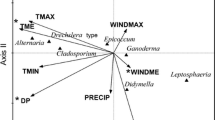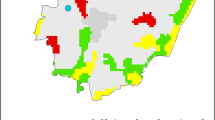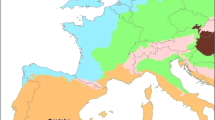Abstract
An aerobiological survey was conducted through five consecutive years (2006–2010) at Worcester (England). The concentration of 20 allergenic fungal spore types was measured using a 7-day volumetric spore trap. The relationship between investigated fungal spore genera and selected meteorological parameters (maximum, minimum, mean and dew point temperatures, rainfall, relative humidity, air pressure, wind direction) was examined using an ordination method (redundancy analysis) to determine which environmental factors favoured their most abundance in the air and whether it would be possible to detect similarities between different genera in their distribution pattern. Redundancy analysis provided additional information about the biology of the studied fungi through the results of the Spearman’s rank correlation. Application of the variance inflation factor in canonical correspondence analysis indicated which explanatory variables were auto-correlated and needed to be excluded from further analyses. Obtained information will be consequently implemented in the selection of factors that will be a foundation for forecasting models for allergenic fungal spores in the future.





Similar content being viewed by others
References
Angelosante Bruno A, Pace L, Tomassetti B, Coppola E, Verdecchia M, Pacioni G, Visconti G (2007) Estimation of fungal spore concentrations associated to meteorological parameters. Aerobiologia 23:221–228
Belsley DA, Kuh E, Welsch RE (1980) Regression diagnostics: identifying influential data and sources of collinearity. Wiley, New York
Bolboacă S-D, Jäntschi L (2006) Pearson versus Spearman, Kendall’s tau correlation analysis on structure-activity relationships of biologic active compounds. LJS 9:179–200
Burch M, Levetin E (2002) Effects of meteorological conditions on spore plumes. Int J Biometeorol 46:107–117
Croux C, Dehon C (2010) Influence function of the Spearman and Kendall correlation measures. SMA 19:497–515
D’Amato G, Spieksma FTM (1995) Aerobiologic and clinical aspects of mould allergy in Europe. Allergy 50:870–877
del Mar Trigo M, Toro FJ, Recio M, Cabezudo B (2000) A statistical approach to comparing the results from different aerobiological stations. Grana 39:252–258
Driscoll P, Lecky F (2001) Article 6. An introduction to hypothesis testing. Parametric comparison of two groups—1. EMJ BMJ 18:124–130
Green BJ, Sercombe JK, Tovey ER (2005) Fungal fragments and undocumented conidia function as new aeroallergen sources. J Allergy Clin Immunol 115:1043–1048
Greene WH (1993) Econometric analysis. Macmillan, New York
Grinn-Gofroń A (2011) Airborne Aspergillus and Penicillium in the atmosphere of Szczecin, (Poland) (2004–2009). Aerobiologia 27:67–76
Grinn-Gofroń A, Bosiacka B (2012) The advanced statistical methods in aerobiological studies. Acta Agrobot 65:69–74
Grinn-Gofroń A, Mika A (2008) Selected airborne allergenic fungal spores and meteorological factors in Szczecin, Poland, 2004–2006. Aerobiologia 24:89–97
Grinn-Gofroń A, Rapiejko P (2009) Occurrence of Cladosporium spp. and Alternaria spp. spores in Western, Northern and Central-Eastern Poland in 2004–2006 and relation to some meteorological factors. Atmos Res 93:747–758
Grinn-Gofroń A, Strzelczak A (2011) The effects of meteorological factors on the occurrence of Ganoderma sp. spores in the air. Int J Biometeorol 55:235–241
Grinn-Gofroń A, Strzelczak A (2013) Changes in concentration of Alternaria and Cladosporium spores during summer storms. Int J Biometeorol 57:759–768
Groß J (2003) Variance inflation factors. R News 3:13–15
Haines JH, Beatriz E, Muilenberg M, Gallup J, Levetin E (2003) Mycology of the air. A workshop manual for sampling and identifying airborne fungus spores. Pan-American Aerobiology Association, Tucson
Hasnain SM (1993) Influence of meteorological factors on the air spora. Grana 32:184–188
Hernández Trejo F, Muñoz Rodríguez AF, Tormo Molina R, Silva Palacios I (2012) Airborne ascospores in Mérida (SW Spain) and the effect of rain and other meteorological parameters on their concentration. Aerobiologia 28:13–26
Hill MO, Gauch HG (1980) Detrended correspondence analysis: an improved ordination technique. Vegetatio 42:47–58
Hirst J (1952) An automatic volumetric spore trap. Ann App Biol 39:257–265
Hollins PD, Kettlewell PS, Atkinson MD, Stephenson DB, Corden JM, Millington WM, Mullins J (2004) Relationships between airborne fungal spore concentration of Cladosporium and the summer climate at two sites in Britain. Int J Biometeorol 48:137–141
Lacey J, Allitt U (1995) Airborne pollen and spores, a guide to trapping and counting. The British Aerobiology Federation, Harpenden
Lacey WE, West J (2006) The air spora. A manual for catching and identifying airborne biological particles. Springer, Dordrecht
Legendre P, Legendre L (1998) Numerical ecology. Elsevier, Amsterdam
Legendre P, Oksanen J, ter Braak CJF (2011) Testing the significance of canonical axes in redundancy analysis. Methods Ecol Evol 2:269–277
Li D-W, Kendrick B (1994) Functional relationships between airborne fungal spores and environmental factors in Kitchener-Waterloo, Ontario, as detected by Canonical correspondence analysis. Grana 33:166–176
Li D-W, Kendrick B (1995) A year-round study on functional relationships of airborne fungi with meteorological factors. Int J Biometeorol 39:74–80
Li D-W, Kendrick B (1996) Functional and causal relationships between indoor and outdoor airborne fungi. Can J Bot 74:194–209
Mimet A, Pellissier V, Quénol H, Aguejdad R, Dubreuil V, Rozé F (2009) Urbanisation induces early flowering: evidence from Platanus acerifolia and Prunus cerasus. Int J Biometeorol 53:287–298
Nikkels AH, Terstegge P, Spieksma FTM (1996) Ten types of microscopically identifiable airborne fungal spores at Leiden, the Netherlands. Aerobiologia 12:107–112
O’Brien RM (2007) A caution regarding rules of thumb for variance inflation factors. Qual Quant 41:673–690
Obolewski K, Strzelczak A (2009) Epiphytic fauna inhibiting Stratiotes aloides in a new lake of the Słowiński National Park (Smołdzińskie lake, Poland). Ecohydrol Hydrobiol 9:257–267
Ogden EC, Raynor GS, Hayes JV, Lewis DM, Haines JH (1974) Manual for sampling airborne pollen. Hafner, New York
Oksanen J, Minchin PR (1997) Instability of ordination results under changes in input data order: explanations and remedies. J Vegetation Sci 8:447–454
Oksanen J, Blanchet FG, Kindt R, Legendre P, Minchin PR, O’Hara RB, Simpson GL, Solymos P, Stevens MHH, Wagner H (2013) Community ecology package. http://cran.r-project.org/web/packages/vegan/vegan.pdf. Accessed 25 Sep 2013
Oliveira M, Ribeiro H, Delgado JL, Abreu I (2009) The effects of meteorological factors on airborne fungal spore concentration in two areas differing in urbanisation level. Int J Biometeorol 53:61–73
Puc M (2012) Artificial neural network model of the relationship between Betula pollen and meteorological factors in Szczecin (Poland). Int J Biometeorol 56:395–401
Recio M, del Mar TM, Docampo S, Melgar M, García-Sánchez J, Bootello L, Cabezudo B (2012) Analysis of the predicting variables for daily and weekly fluctuations of two airborne fungal spores: Alternaria and Cladosporium. Int J Biometeorol 56:983–991
Richardson MJ (1996) The occurrence of airborne Didymella spores in Edinburgh. Mycol Res 100:213–216
Rodríguez-Rajo FJ, Jato V, Fernández-González M, Jesus Aira M (2010) The use of aerobiological methods for forecasting Botrytis spore concentrations in a vineyard. Grana 49:56–65
Sabariego S, Díaz de la Guardia C, Alba F (2000) The effect of meteorological factors on the daily variation of airborne fungal spores in Granada (southern Spain). Int J Biometeorol 44:1–5
Simon-Nobbe B, Denk U, Pöll V, Rid R, Breitenbach M (2008) The spectrum of fungal allergy. Inte Arch Allergy Immunol 145:58–86
Simpson GL (2013) Functions for generating restricted permutations of data. http://cran.r-project.org/web/packages/permute/permute.pdf. Accessed 25 Sep 2013
Southworth D (1974) Introduction to the biology of airborne fungal spores. Ann Allergy 32:1–22
Stennet PJ, Beggs PJ (2004) Alternaria spores in the atmosphere of Sydney, Australia, and relationships with meteorological factors. Int J Biometeorol 49:98–105
Stępalska D, Wołek J (2005) Variations in fungal spore concentrations of selected taxa associated to weather conditions in Cracow, Poland, in 1997. Aerobiologia 21:43–52
Stępalska D, Wołek J (2009) The estimation of fungal spore concentrations using two counting methods. Acta Agrobot 62:117–123
Stępalska D, Grinn-Gofroń A, Piotrowicz K (2012) Occurrence of Didymella ascospores in western and southern Poland in 2004–2006. Aerobiologia 28:153–159
Teixeira Gonçalves FL, Bauer H, Alves Cardoso MG, Pukinskas S, Matos D, Melhem M, Puxbaum H (2010) Indoor and outdoor atmospheric fungal spores in the São Paulo metropolitan area (Brazil): species and numeric concentrations. Int J Biometeorol 54:347–355
ter Braak CJF (1986) Canonical correspondence analysis: a new eigenvector technique for multivariate direct gradient analysis. Ecology 67:1167–1179
ter Braak CJF (1995) Ordination. In: Jongman RHG, ter Braak CJF, van Tongeren OFR (eds) Data analysis in community and landscape ecology, 1st edn. Cambridge University Press, Cambridge, pp 91–173
ter Braak CJF, Prentice IC (1988) A theory of gradient analysis. Adv Ecol Res 18:271–317
Wagner HH (2004) Direct multi-scale ordination with canonical correspondence analysis. Ecology 85:342–351
Acknowledgements
This project has been funded by the National Pollen and Aerobiology Research Unit at the University of Worcester and conducted within the framework of the doctoral studies of the first author.
Author information
Authors and Affiliations
Corresponding author
Electronic supplementary material
Below is the link to the electronic supplementary material.
ESM 1
(DOCX 32 kb)
Rights and permissions
About this article
Cite this article
Sadyś, M., Strzelczak, A., Grinn-Gofroń, A. et al. Application of redundancy analysis for aerobiological data. Int J Biometeorol 59, 25–36 (2015). https://doi.org/10.1007/s00484-014-0818-4
Received:
Revised:
Accepted:
Published:
Issue Date:
DOI: https://doi.org/10.1007/s00484-014-0818-4




